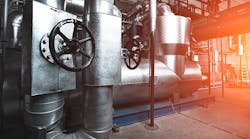Over the past 40 years, I have participated in several studies of organic Rankine cycles (ORCs) for recovering low-grade waste heat from chemical and oil refinery processes. ORCs resemble the steam Rankine cycles commonly used for power generation in the process industries — except that, instead of water, the working fluid is a volatile hydrocarbon that better suits operation at low temperatures.
The outcome of our studies has always been the same: “It’s an interesting technology, but the economics don’t work.” The reason is inherent in thermodynamics and, specifically, the Carnot efficiency equation that we discussed in August’s column (“Speak the Language of Energy Efficiency"). If the temperature of the waste heat is low, the maximum efficiency (useful power out/total heat in) also is low. Even if you assign zero cost to the waste heat supplied to the ORC, you still must install a significant amount of equipment (ducting, heat exchangers, expander, electric generator, etc.); we were never able to achieve an acceptable rate of return.
But the times are a-changin.’ Improved, standardized equipment, manufactured in larger numbers, has cut the unit cost of ORCs. Meanwhile, the economic and societal drivers for waste heat recovery have become much stronger. Loy Sneary, president of Gulf Coast Green Energy, Bay City, Texas, provided the following summaries of three recent ORC projects he facilitated, using ElectraTherm’s ORC technology, the Power+ waste heat-to-power generator.
Flare reduction. Here, the ORC was deployed at a Hess Corporation North Dakota oil well pad to demonstrate how waste-heat-to-power technology can reduce flare gas and emissions at the well-head, while producing on-site power. The equipment captures gas, which would otherwise be flared, to fuel a heater that drives the ORC cycle. This provides a practical option for energy recovery in a situation where flaring has previously been considered the only viable solution. In this application, the ORC generates up to 120 kWe of electricity for a single unit and units can be connected in a series. Furthermore, a study by Texas A&M Institute of Renewable Natural Resources, College Station, Texas, verified the following emissions reductions, compared to the flaring option: CO: 89%; NOx: 48%; VOCs: 93%.
Process fluid heat-to-power. Denbury Resources installed an ORC at an oilfield in Mississippi. The ORC recovers heat from produced water supplied at between 190 and 300°F, and makes up to 120 kWe of power. This offsets electric consumption on the site, and also cools the produced water, reducing the temperature by 20–30°F, which can greatly reduce the cost of cooling the liquid. Installation took less than 8 hours, with minimal production disruption.
This approach can be applied anywhere requiring cooling of liquids between 190 and 300°F.
Radiator replacement. This application, carried out for the U.S. Department of Defense, was the first fully-integrated stationary engine generator (1.1 MW genset) and waste-heat-to-power generator. It was tested at the Port Hueneme, Calif., naval base and shipped to Guantanamo Bay, Cuba, for prime power generation. The installation received a successful third-party verification report by Southern Research Institute.
The ORC displaces the radiator’s capital cost and parasitic load, generates additional power, reduces fuel consumption and emissions, and adds resiliency to the genset. Moreover, the ORC system cools the engine even if it is not producing power, so supplemental cooling is not required. Remote monitoring and control enhance ease of operation.
None of these installations are inside a chemical plant or oil refinery, but obvious similarities exist to the types of processes and equipment we encounter in our facilities — especially in the produced water example. The main message is that the technology has been successfully demonstrated. There is a strong and growing desire across industry to find uses for low-grade waste heat, and ORC technology is definitely an option to consider.
Do you have waste heat streams in your plant that might be good candidates? If so, perhaps it’s time to evaluate the potential for an ORC. Let me know what opportunities you find.



